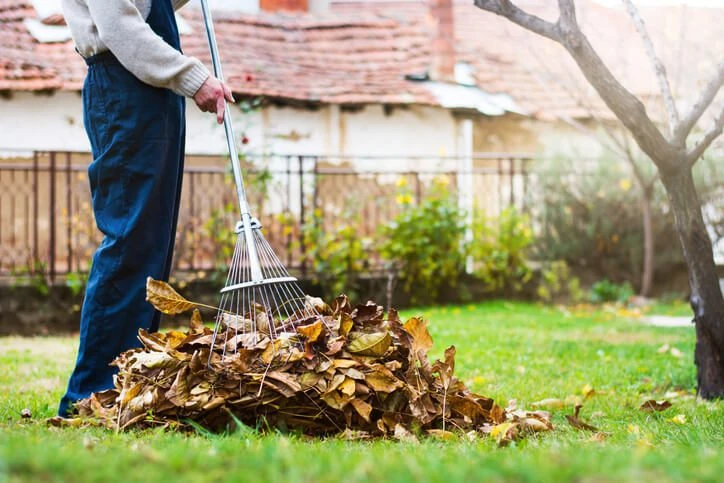It’s that time of year again. Frost is in the air and homeowners are at a loss, yet again, for how they should maintain their yard during the fall.
If this describes your situation — buckle up! You’ve come to the right place. To help you keep your lawn in pristine condition through this breezy season, the team here at New Life Rockeries has thrown together our 8 favorite fall lawn maintenance tips.
Taking adequate care to maintain your lawn during the fall will ensure that your lawn is healthy, thick, and lush when springtime rolls around.

Here are 8 tips for lawn care and maintenance this fall, from professional landscapers.
1. Take Care Of Dead Leaves & Grass
This fall lawn maintenance tip will ensure that you have a healthy lawn throughout the winter and on into the springtime.
Leaving dead leaves and grass in place will smother the lawn underneath and prevent essential sunlight from reaching it.
Take the time to carefully rake and dispose of all dead leaves and replace dead grass.
2. Have Your Irrigation Systems Winterized
An essential fall lawn maintenance tip is to have your irrigation systems winterized. Leaving irrigation pipes with water in them all winter long could result in expensive repairs in the future.
This is a fall lawn maintenance tip that should involve the help of a landscaping professional. As autumn is in full swing in the Pacific Northwest, you should schedule a crew to come to winterize your irrigation immediately.
3. Check & Clean Gutters
Now we come to the dreaded one — checking and maintaining the gutters.
During fall, it is very common for leaves and debris from surrounding trees to clog up gutters. Since this could cause maintenance issues for your house as well as your lawn, you should pull out your handy ladder and check your gutters as part of your fall lawn maintenance this season.
4. Clean & Organize Your Lawn Maintenance Shed
This fall maintenance tip will help you so much in the springtime when you prepare to spruce up your home for the year. Take an afternoon to put all your lawn maintenance tools back in place, clean them, and make sure they are all organized for the following year.
5. Decorate Your Lawn For The Holidays
Our favorite fall lawn maintenance tip — prepare your lawn for the holiday season by decorating!
After you’ve adequately cared for your lawn and prepared it for winter and fall, spend an afternoon with your family to decorate your lawn for the upcoming holidays. String the house with lights and add fun lawn decor to your yard in anticipation of the holidays.
6. Keep Up With Lawn Pest Control
Homeowners often mistakenly think that they don’t need to keep up with lawn pest control during the fall and winter months. This, however, is not the case. Insects and pests might just be getting cozy in your lawn now, but when springtime rolls around they are going to wreak havoc on the health of your lawn.
Make sure that you address any pest problems before winter is in full force and care for your lawn by getting rid of unwanted insects.
7. Feed & Water Your Lawn When Needed
Just because it’s fall doesn’t mean that you can ignore feeding and watering your lawn. On occasion, you may still need to water your lawn — despite living in Washington State.
Keep track of how often it rains and maintain your yard this fall through watering and fertilizing when needed.
Additionally, don’t forget to fertilize your lawn during the fall months. It’s especially important to use a fertilizer that is rich in nitrogen during the fall. This type of fertilizer will nourish your lawn throughout the fall and winter months and is one of the best ways that you can care for your lawn this autumn.
8. Continue Cutting Your Lawn
We’re not just talking mowing your lawn throughout the fall and winter whenever you get the urge. You should be routinely mowing your lawn and cutting it to the correct height.
Until you’ve had the first frost, your grass will continue growing and you should continue caring for it by mowing it one schedule to encourage optimal health and growth.
Talk With Fall Maintenance Experts Today
Need some help caring for your lawn this fall?
You’ve come to the right place! Our expert team of landscape contractor at New Life Rockeries has the skills needed to help you maintain your lawn this fall. We have been helping homeowners in the Pacific Northwest to care for and maintain their lawns throughout the fall and winter months and want to help you as well.
If you have any concerns or questions about fall lawn care or want to schedule our team to come out and winterize your irrigation systems, give New Life Rockeries a call today or contact us here.
